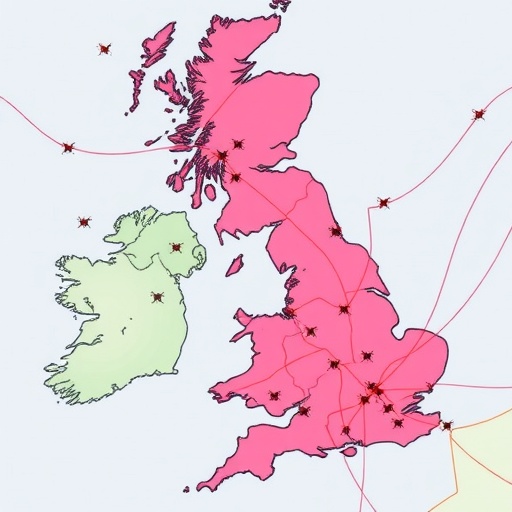Belém, Brazil – Gland, Switzerland (11 September 2025) — Recent groundbreaking research published in Communications Earth and Environment, a renowned Nature Group journal, sheds new light on the critical role Indigenous territories play in safeguarding human health across the Amazon basin. By meticulously analyzing two decades of health and environmental data from eight Amazonian countries, the study provides compelling evidence that Indigenous-managed forests mitigate the increasing risks of diseases linked to forest fires and zoonotic transmission. This research offers an unprecedented glimpse into the intersection of environmental conservation, Indigenous land rights, and public health, revealing that these factors are inextricably intertwined.
The Amazon rainforest, often described as the planet’s lungs, is not only vital for biodiversity and climate regulation but also serves as a buffer against a swath of health hazards. Forest fires, driven predominantly by illegal deforestation to clear land for agriculture and cattle ranching, emit vast quantities of particulate matter and toxic gases, exacerbating respiratory and cardiovascular diseases throughout the region. This study’s data-driven approach connects the dots between the integrity of forest landscapes, the stewardship exercised by Indigenous communities, and the resultant health outcomes on a large scale.
By examining 27 specific health indicators—21 related directly to fire exposure and six associated with zoonotic or vector-borne illnesses such as Chagas disease, malaria, and leishmaniasis—the researchers uncovered a consistent pattern: municipalities adjacent to Indigenous lands with intact forest cover experienced significantly lower incidence rates of these diseases. The protective effect of Indigenous territories operates through multiple mechanisms, including the maintenance of dense forest canopies that filter air pollutants and the conservation of biodiversity that disrupts the proliferation of disease vectors.
The study’s authors emphasize the importance of landscape structure and legal land tenure status in shaping these benefits. Legal recognition of Indigenous land rights guarantees stewardship continuity and constrains deforestation, fostering forest resilience against increasingly intense and frequent wildfires exacerbated by climate change. The legal framework also strengthens Indigenous communities’ capacity to implement traditional ecological knowledge and land management practices that inhibit the onset and spread of fire.
Climate models have long projected rising temperatures and more erratic rainfall patterns throughout the Amazon, conditions that create a tinderbox environment prone to severe wildfires. When these fires ignite, whether naturally or through anthropogenic means, the smoke they produce infiltrates vast areas downwind, often far removed from the ignition sites themselves. This dispersion leads to acute and chronic health problems, particularly for vulnerable groups such as children, the elderly, and those with pre-existing respiratory or cardiovascular conditions.
The repercussions are profound: between 2001 and 2019, nearly 30 million cases of diseases linked to fire exposure and zoonotic transmission were reported throughout the Amazon region. Notably, the Brazilian Amazon alone recorded an average of 2,906 premature deaths per year from cardiopulmonary diseases and lung cancer attributable to fire smoke during 2002-2011. This staggering toll underscores the importance of preventive measures grounded in forest conservation and Indigenous stewardship.
Further compounding these health challenges is the rise in so-called neglected tropical diseases, which disproportionately affect impoverished and rural populations in the Amazon. The encroachment of deforestation destabilizes ecosystems, facilitating closer human contact with animals and insects that act as reservoirs and vectors for these illnesses. By maintaining forest cover and ecosystem integrity, Indigenous territories play a pivotal role in interrupting disease transmission cycles, providing an often-overlooked public health service.
The data/statistical analysis methodology employed in this research leverages a comprehensive dataset spanning almost twenty years across eight countries: Bolivia, Brazil, Colombia, Ecuador, Peru, Suriname, Venezuela, and French Guiana. This expansive scope enabled the disentanglement of complex environmental and social variables, strengthening the conclusions about causality and reinforcing calls for policy reforms. The robustness of these findings marks a significant advancement in understanding how environmental governance directly impacts human health outcomes.
Paula Prist, Senior Programme Coordinator for the Forests and Grasslands Programme at the International Union for Conservation of Nature (IUCN), highlights the convergence of ecological and medical insights demonstrated by this study. She articulates that the benefits of Indigenous forests extend beyond preserving biodiversity and carbon stocks; these forests actively reduce respiratory and cardiovascular risks among millions, emphasizing the multifaceted value of Indigenous land rights. Protecting these rights is framed not just as a matter of justice but as a strategic imperative for global health and environmental security.
With the onset of the fire season heralding elevated health risks across Amazonian communities, the timing of this research is particularly urgent. Ana Filipa Palmeirim, one of the study’s lead authors, warns of the immediate public health crises triggered by wildfire smoke, including spikes in hospital admissions for respiratory issues and the debilitating social disruptions imposed by smoke-laden air quality. Her observations underscore the need for integrated policies that incorporate Indigenous stewardship as a frontline defense mechanism.
The study also contextualizes the threats posed by illegal land clearing methods, where actors intentionally set fires to expand agricultural frontiers, often undermining national and international conservation efforts. Combined with climate-driven increases in wildfire severity, these activities jeopardize both ecosystem services and human health. Emphasizing the power of Indigenous governance, the research advocates for strengthening legal frameworks, supporting Indigenous monitoring systems, and curtailing illegal deforestation through concerted transnational cooperation.
Finally, this research cements a vital nexus linking environmental sustainability, Indigenous rights, and public health resilience. In a world grappling with accelerating climate change and emerging infectious diseases, it provides a hopeful blueprint for harnessing Indigenous stewardship to protect both people and the planet. By recognizing and upholding the land claims of Indigenous Peoples in the Amazon, policymakers can simultaneously tackle biodiversity loss, climate change mitigation, and critical health challenges threatening millions.
Subject of Research: People
Article Title: Indigenous Territories can safeguard human health depending on the landscape structure and legal status
News Publication Date: 11-Sep-2025
Web References:
DOI: 10.1038/s43247-025-02620-7
Original Article in Communications Earth & Environment
References:
Study authors examined 20 years of health and environmental data from Bolivia, Brazil, Colombia, Ecuador, Peru, Suriname, Venezuela, and French Guiana, focusing on incidences of fire-related and zoonotic diseases in relation to forest integrity and Indigenous land tenure.
Keywords: Indigenous territories, Amazon rainforest, forest fires, zoonotic diseases, vector-borne diseases, respiratory diseases, cardiovascular health, deforestation, Indigenous land rights, wildfire smoke, neglected tropical diseases, public health, climate change, environmental governance




